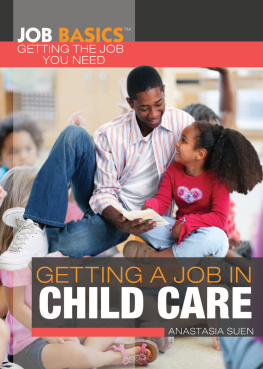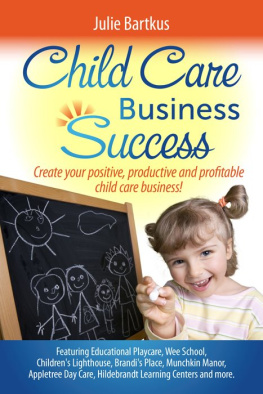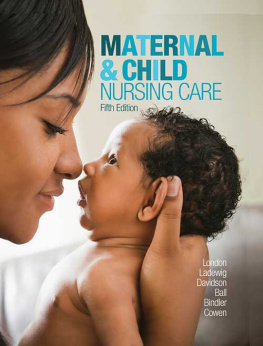Published in 2014 by The Rosen Publishing Group, Inc.
29 East 21st Street, New York, NY 10010
Copyright 2014 by The Rosen Publishing Group, Inc.
First Edition
All rights reserved. No part of this book may be reproduced in any form without permission in writing from the publisher, except by a reviewer.
Library of Congress Cataloging-in-Publication Data
Suen, Anastasia.
Getting a job in child care/by Anastasia Suen.1st ed.New York: Rosen, c2014 p. cm.(Job basics: getting the job you need)
Includes bibliographical references and index.
ISBN 978-1-4488-9612-7
1. Child careVocational guidanceJuvenile literature. 2. Child care Vocational guidanceUnited StatesJuvenile literature. I. Title.
HQ778.5 S84 2014 649.02373
Manufactured in the United States of America
CPSIA Compliance Information: Batch #S13YA: For further information, contact Rosen Publishing, New York, New York, at 1-800-237-9932.
P arents everywhere need child care. What that looks like is different for each family. Jennifer takes her baby to a family home every morning on her way to work. The mother in this home has her own small children. She can take care of one or two more without a license from the state.
Linda takes her one-year-old child to a family home each morning. The six children who go to this licensed child care center dont live there. They play in a child care room made just for them. There is also play equipment for them in the backyard.
Brittanys two young children arrive at a larger family child care center at 6:30 AM. Two women care for sixteen children during the day. Brittanys two-year-old stays at the center all day. After Brittanys six-year-old eats breakfast, she goes to the elementary school across the street. A day care worker takes her to school in the morning and picks her up in the afternoon.
Tamika and her five-year-old go to work together in the morning and come home together at night. While Tamika works at the hospital, her son is learning his letters at the employee child care center.
Lauren often travels for work, so she has a nanny for her two children. The nanny lives with the family and works six days a week. Laurens nanny drives the children to school in her own car.The nanny also shops for the family and prepares all of the meals.
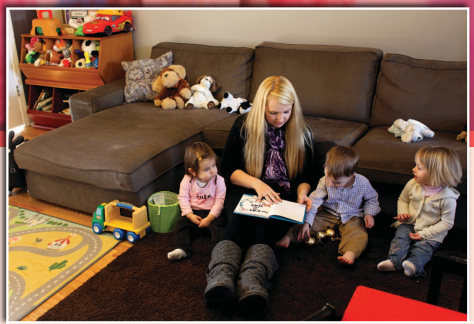
Sarah Simanskey runs a family child care center in her home. Here, she reads to her two-year-old son and two other young children in her care.
Jennifer takes her two children to elementary school in the morning on her way to work. At the end of the school day, they go to the school gym for after-school care. Jennifers children eat snacks and play games. They also do their homework before she picks them up at 6:30 PM.
There are a lot of child care options for parents. All of those options need trained child care workers. Will you watch children in a home day care or work as an assistant in a family child care center?
Maybe you can live with a family and be a nanny or a manny (a male nanny). You wont have to pay rent while you are there. That will cut down on your expenses.
A job in a child care center may be right choice for you.You will work with children and other adults in a structured setting.
There are child care jobs out there waiting for you. Before you start, lets see what the job is like day to day. Well explore what kind of training youll need. The good news is you can start getting ready for work right now, even if you are still in high school.
Practical steps come next. Well talk about how to find a job listing and what to add to your resume. Then well cover the all-important interview. What will they ask you, and what will you ask them? (Yes, you have to interview your employer, too.)
After you are hired, there is still more to do. You need to bring in your paperwork and fill out even more. Taxes, health insurance, and continued training are all necessary. You dont need a college degree to work in child care, but you do need to keep training to keep your job.The good news is, now your employer can pay for it!
W hen you work in a child care job, you are responsible for taking care of children.You fill in for the parents while they go to work. Becoming a surrogate parent is really your job. What will you do during the day? Lets look at a chart from the Bureau of Labor Statistics Occupational Outlook Handbook listing for child care workers.
Child care workers typically do the following:
- Supervise and monitor the safety of children in their care
- Prepare meals and organize mealtimes and snacks for children
- Help children keep good hygiene
- Change the diapers of infants and toddlers
- Organize activities so that children can learn about the world and explore interests
- Develop schedules and routines to ensure that children have enough physical activity, rest, and playtime
- Watch for signs of emotional or developmental problems in children and bring the problems to the attention of parents
- Keep records of childrens progress, routines, and interest
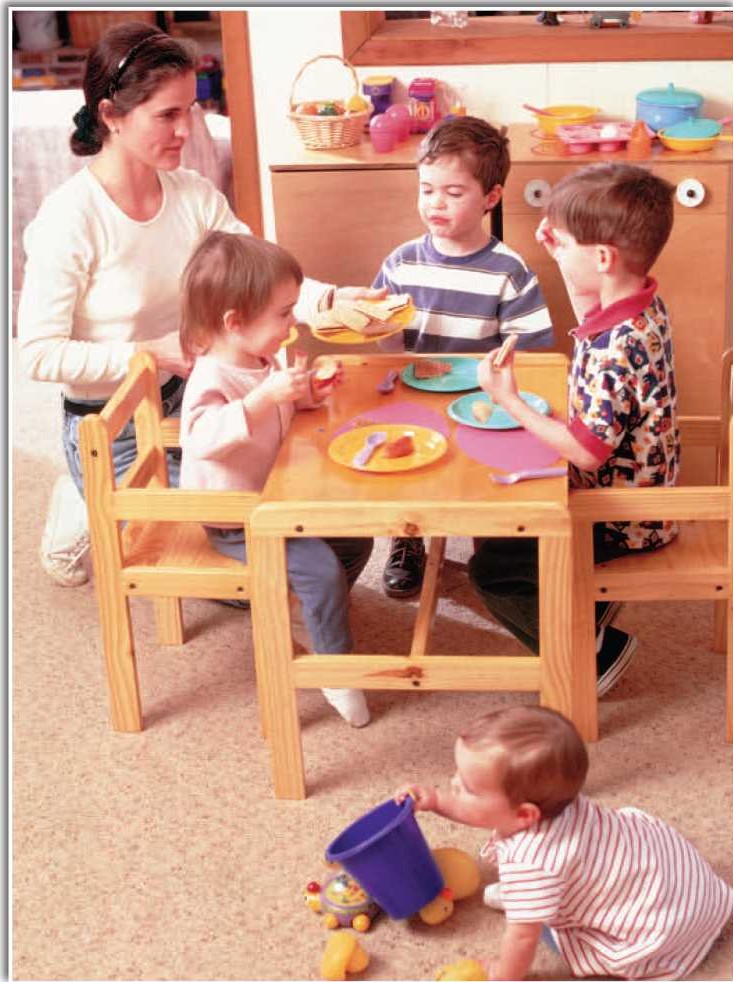
In a family child care center, the children eat and play just like they do at home. These children are eating their snacks in their play kitchen.
A parent does all of this every day, and so will you. The biggest difference is that you must also report all of this to the childs parents.You will need to keep a log of what each child does throughout the day. For infants, this means that every bottle given and every diaper changed is written in the log. If a child falls while learning how to stand, that is recorded, too. So is the first time the child can stand by himself or herself. Everything the child does during the day is written in the log for the parents.
Where the Jobs Are
So many parents today work, and someone needs to take care of all the children. That opens job possibilities for you. Lets look at the last census and see where the jobs are.
Every ten years the country takes a census. Its like taking roll in school. Names and ages are written down house by house across the country. The type of job each person has is also included. (On the 2010 census, your job was probably listed as student.)
In 2010, there were more than 1.3 million jobs in child care. Lets drill a little deeper and see where those jobs were.
Bureau of Labor Statistics 2010 Child Care Workers Job Chart:
Child day care services: 22%
Private households: 15%
Elementary and secondary schools: 11%
Religious, grantmaking, civic, professional, and similar organizations: 8%
Choices
The good news for you is that there are a lot of choices. And those choices will continue to grow. The Bureau of Labor Statistics says that employment of child care workers is expected to grow by 20 percent from 2010 to 2020, faster than the average for all occupations.

